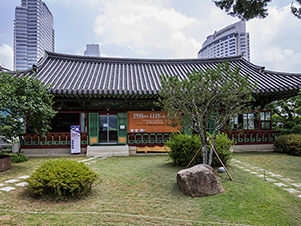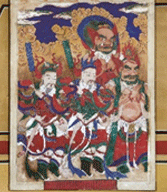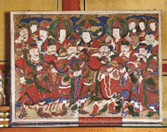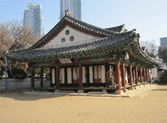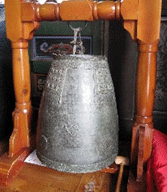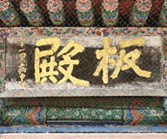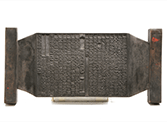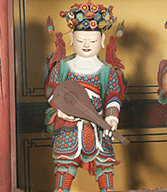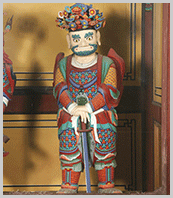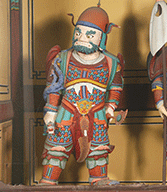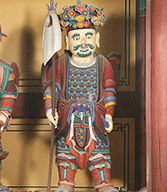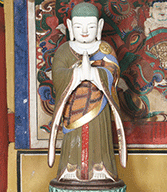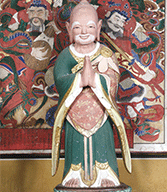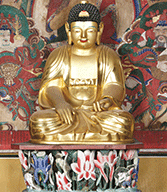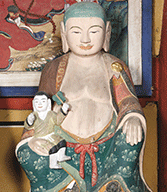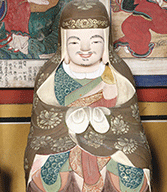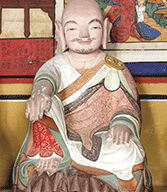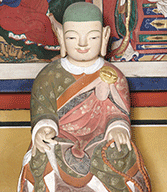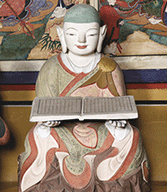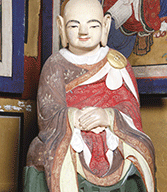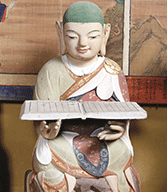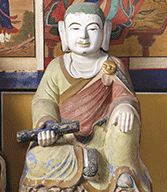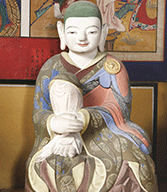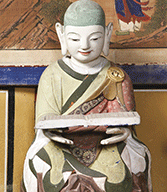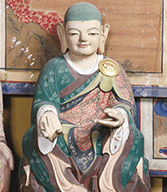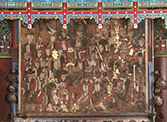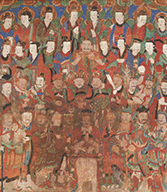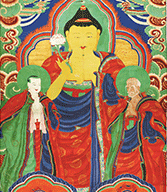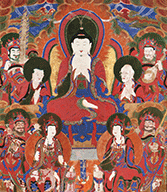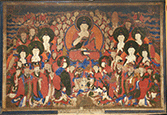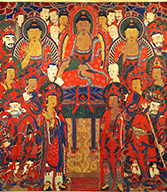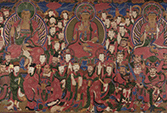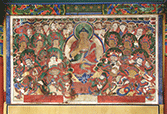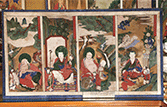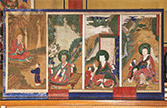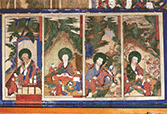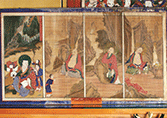- HOME
- Introduction
- Temple Overview
Temple Overview
The Practicing Temple for the Revival of Korean Buddhism
Bongeunsa is a millennial Buddhist temple with a long history of over more than 1,200 years old, located at Samseong-dong, Gangnam-gu, in the center of Seoul City, Korea.
Founded by National Master Patriarch Yeonhoei in 794 during the reign of King Wonseong of the Shilla Dynasty, Bongeunsa later became the cornerstone of the revival of Korean Buddhism as the head temple of the Korean Seon(meditation) lineage owing greatly to the religious devotion of the Venerable Bowoo. National examination qualifying monks took place in this area of the current COEX location, which was called ‘Seunggwapyeong’ at that time. Distinguished masters including the Venerable Seosan and the Venerable Samyeong, who carried on the Seon(meditation) legacy of Korean Buddhism, were produced right here through the system.
During the late Joseon Dynasty, the Venerable Yeonggi built Panjeon, where 81 volumes of the wood blocks of the Avatamsaka Sutra are enshrined. Also, Kim Jeonghee, one of the greatest scholars and calligraphers of the time, stayed at Bongeunsa Temple in his latter years and completed his own calligraphy style called the ‘Chusache’ style named after his pen name.
His caligraphy displayed on the hanging board at the Panjeon is known as his last work representing his Chusache style at the highest level of calligraphic art.
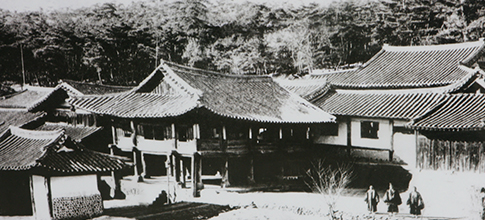 Behind the old landscape of the Bongeunsa Temple of the 1920s now lies a lush forest of pine trees.
Behind the old landscape of the Bongeunsa Temple of the 1920s now lies a lush forest of pine trees.
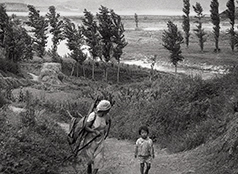 The way to the Bongeunsa Temple in the past.
The way to the Bongeunsa Temple in the past.
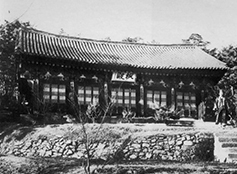 过去的Panjeon ( Tripitaka Hall )照片
过去的Panjeon ( Tripitaka Hall )照片
Nowadays, Bongeunsa is writing a new history of Korean Buddhism through its practice-oriented temple management.
More over, Bongeunsa not only spreads Korean Buddhism and Korean culture at home and around the world with diversified programs including Templestay, but also continues to maintain its place as a important sizable temple with contribution to the public welfare in the center of Korean society.
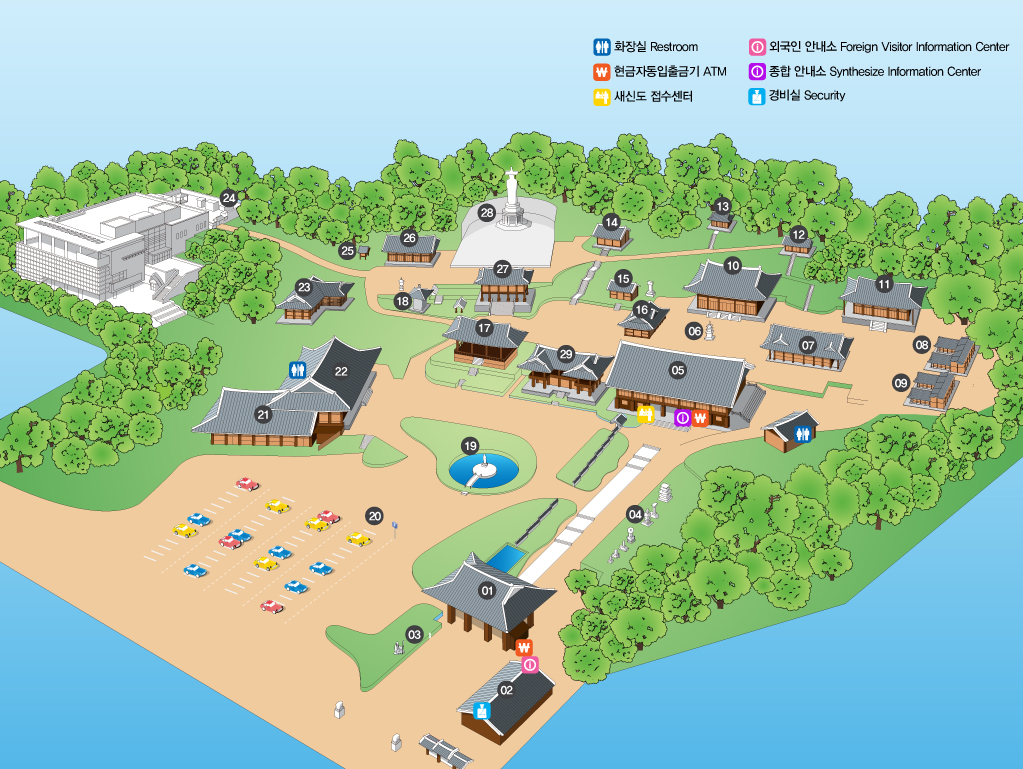
- 1. Jinyeomun Gate
- 2. Eunghyanggak ( Buddhist Goods Store )
- 3. Haeundang( Information Center )
- 4. Stone Monument ( Budojeon )
- 5. Beopwangru ( The Dharma Hall )
- 6. Three Story Stone Pagodat
- 7. Seonbuldang
- 8. Traditional Culture Center Hall 1
- 9. Traditional Culture Center Hall 2
- 10. Daewoongjeon ( The Main Buddha Hall )
- 11. JIjangjeon ( Kshtigarbha Hall )
- 12. Yeongsanjeon ( Disciples Hall )
- 13. Bukgeukbojeon
- 14. Yeonggak
- 15. Unhadang
- 16. Shimgumdang
- 17. Bell Pavilion
- 18. Bell Tower
- 19. The Statue of Yeonji Gwanseum
- 20. Parking Lot
- 21. Hyangjeokwon ( Dining Hall )
- 22. Bowoodang
- 23. Daraeheon
- 24. Bongeun Seonwon( Seon Meditation Center )
- 25. Bigak
- 26. Panjeon ( Tripitaka Hall )
- 27. Mireukjeon ( Maitreya Hall )
- 28. The Great Statue of Maitreya Buddha
- 29. Traditional teahouse
- 1. Jinyeomun Gate
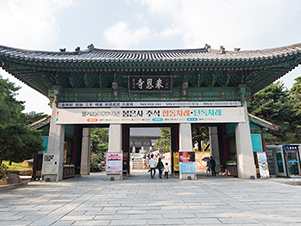 The first main entrance of the temple compound is called the One-lined Pillar Gate. At the Bongeunsa Temple, it is also called the Jinyeomun. Jinyeo means "as it is" and the ultimate truth without any discrimination. So, entering the Jinyeomun means searching for the Real Truth.
The first main entrance of the temple compound is called the One-lined Pillar Gate. At the Bongeunsa Temple, it is also called the Jinyeomun. Jinyeo means "as it is" and the ultimate truth without any discrimination. So, entering the Jinyeomun means searching for the Real Truth.
- 2. Eunghyanggak ( Buddhist Goods Store )
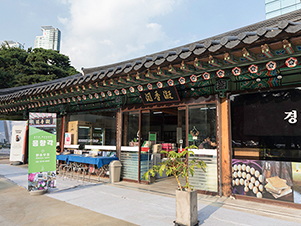 It is a Buddhist goods shop where sells offerings to the Buddha for lay people and visitors. This is more than just a simple shop, and it is a place to provide informations about Buddhism sharing their minds.
It is a Buddhist goods shop where sells offerings to the Buddha for lay people and visitors. This is more than just a simple shop, and it is a place to provide informations about Buddhism sharing their minds.
- 3. Haeundang( Information Center )
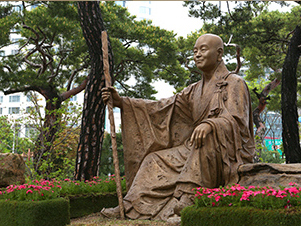 The great Master Huhengdang Bowoo was assigned as the Head Monk of Bongeunsa in the period of King Myeongjong and King Jeongjong of severe Buddhism persecution age. He restored Korean Buddhism with the support of Queen Munjeong. Later he was wrongly accused by many Confucian scholars and finally he was exiled to Jeju island and was martyred there in 1565. We established his statue in memory of him on Buddha's Birthday in 2013 with our whole heart and sincerity.
The great Master Huhengdang Bowoo was assigned as the Head Monk of Bongeunsa in the period of King Myeongjong and King Jeongjong of severe Buddhism persecution age. He restored Korean Buddhism with the support of Queen Munjeong. Later he was wrongly accused by many Confucian scholars and finally he was exiled to Jeju island and was martyred there in 1565. We established his statue in memory of him on Buddha's Birthday in 2013 with our whole heart and sincerity.
- 4. Stone Monument( Budojeon )
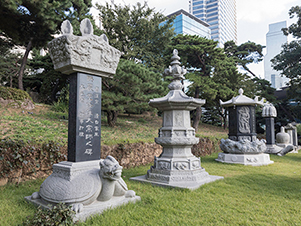 After passing the main gate, you will see several stone monuments on your right side. The first and the second steles are for the Master Yeongam who was the Head Monk of the Bongeunsa Temple in 1980s. The third Pagoda is dedicated to Venerable Bowoo. The fourth monument describes the history of this temple. The fifth bell-style Pagoda is dedicated to Master Cheongho. On May, 1925 when the big flood overflowed in the Han River, he saved 708 lives and took care of them in this temple. The last one is for Master Yeonggi and other 16 small monuments are for great Buddhist donors.
After passing the main gate, you will see several stone monuments on your right side. The first and the second steles are for the Master Yeongam who was the Head Monk of the Bongeunsa Temple in 1980s. The third Pagoda is dedicated to Venerable Bowoo. The fourth monument describes the history of this temple. The fifth bell-style Pagoda is dedicated to Master Cheongho. On May, 1925 when the big flood overflowed in the Han River, he saved 708 lives and took care of them in this temple. The last one is for Master Yeonggi and other 16 small monuments are for great Buddhist donors.
- 5. Beopwangru( The Dharma Hall )
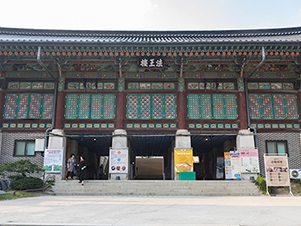 "Beopwang-ru" literally means Pavilion of 'Dharma King', the Buddha. So this pavilion faces Daewoongjeon that is the Main Buddha Hall and is used for various religious services such as morning ceremonies, grand Dharma meetings, prayers and meditation practices. Enshrined in the hall are 3,300 small statues of Avalokitesvara, the Bodhisattva of Compassion.
"Beopwang-ru" literally means Pavilion of 'Dharma King', the Buddha. So this pavilion faces Daewoongjeon that is the Main Buddha Hall and is used for various religious services such as morning ceremonies, grand Dharma meetings, prayers and meditation practices. Enshrined in the hall are 3,300 small statues of Avalokitesvara, the Bodhisattva of Compassion.
- 6. Three Story Stone Pagoda
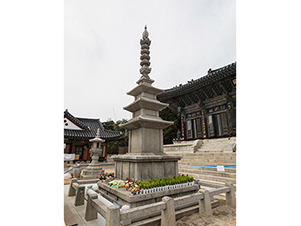 A piece of Sakyamuni Buddha's sarira is enshrined inside this traditional three-story stone pagoda in Bongeunsa Temple.
A piece of Sakyamuni Buddha's sarira is enshrined inside this traditional three-story stone pagoda in Bongeunsa Temple.
- 7. Seonbuldang
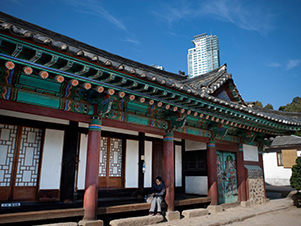 In 1939, most parts of the Bongeunsa Temple except Panjeon were burned down by a big fire. In 1941, Master monk Ilcho Taewook built Seonbuldang at the site of Shimgumdang. Seonbuldang owes the originality of its structure to its Paljak roof style with six gables and means practicing place to attain enlightenment.
In 1939, most parts of the Bongeunsa Temple except Panjeon were burned down by a big fire. In 1941, Master monk Ilcho Taewook built Seonbuldang at the site of Shimgumdang. Seonbuldang owes the originality of its structure to its Paljak roof style with six gables and means practicing place to attain enlightenment.
- 10. Daewoongjeon ( The Main Buddha Hall )
-
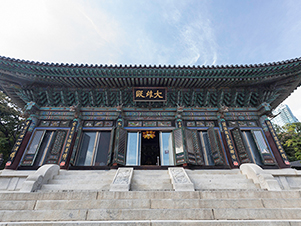
Daewoongjeon was rebuilt in 1982. Inside the hall, the Statues of three wooden sitting Buddhas are enshrined (National Treasure, No.1819). In the center is the Sakyamuni Buddha with the Medicine Buddha (Bhaisajyaguru) on his left and the Amitabha Buddha of the Western Pure Land (the Buddha of infinite Light) on his right. Behind the statues of the three Buddhas, there is a beautiful painting portraying the theme of the three Buddhas. Also unique architectural features add dignity to its beauty: the dragon image on the railing of the stairs, which was used exclusively for the palaces of kings. The pillars, stylish window frames, roofs and eaves also show the echo-friendly beauty of traditional wooden buildings of Korea.
- 11. Jijangjeon ( Kshtigarbha Hall )
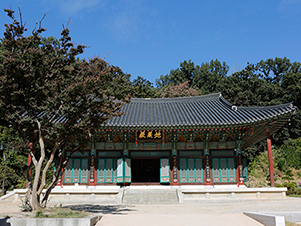 Ksitigarbha Bodhisattva is enshrined in this building. He guides the dead spirits over to the Pure Land of western paradise where Amitabha Buddha resides. This Bodhisattva, who is also reffered to as the Great Vow Bodhisattva. is said to have maid a vow to save all sentient beings from all sufferings next passing away of Sakyamuni Buddha. He stays in hell to save all suffering beings until no one remains there.
Ksitigarbha Bodhisattva is enshrined in this building. He guides the dead spirits over to the Pure Land of western paradise where Amitabha Buddha resides. This Bodhisattva, who is also reffered to as the Great Vow Bodhisattva. is said to have maid a vow to save all sentient beings from all sufferings next passing away of Sakyamuni Buddha. He stays in hell to save all suffering beings until no one remains there.
- 12. Yeongsanjeon ( Disciples Hall )
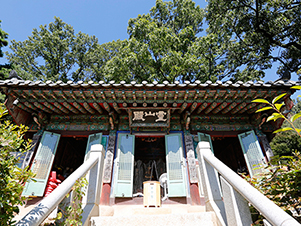 Enshrined in the center of this hall is a Statue of the Sakyamuni Buddha, with a statue of Mahakashyapa on his left, Ananda on his right and 16 Arahants are on both sides. Buddhist Paintings such as the painting of Buddha, the painting of Guardian Deities and paintings of portraits of sixteen Arahants bring the atmosphere of this hall. In Korea, Buddhists believe that Arahants have supernatural powers and respond quickly to the Buddhists' wishes. That is the reason why many Buddhists pray for their wishes here.
Enshrined in the center of this hall is a Statue of the Sakyamuni Buddha, with a statue of Mahakashyapa on his left, Ananda on his right and 16 Arahants are on both sides. Buddhist Paintings such as the painting of Buddha, the painting of Guardian Deities and paintings of portraits of sixteen Arahants bring the atmosphere of this hall. In Korea, Buddhists believe that Arahants have supernatural powers and respond quickly to the Buddhists' wishes. That is the reason why many Buddhists pray for their wishes here.
- 13. Bukgeukbojeon
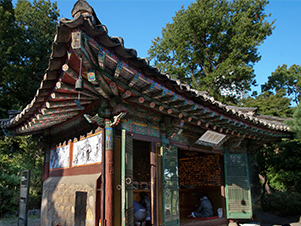 Bukgeukbojeon and Yeongsanjeon were reconstructed in 1942. The Big Dipper, the Mountain Spirit and the Hermit-Saint are enshrined in Bukgeukbojeon. The seven stars of the Big Dipper were historically regarded among people as a god responsible for health, longevity, wealth, fertility and a good harvest. This building shows Korean Buddhism embraced this traditional folk beliefs. [traditionally called this building as the Chilseong-gak or Samseong-gak.]
Bukgeukbojeon and Yeongsanjeon were reconstructed in 1942. The Big Dipper, the Mountain Spirit and the Hermit-Saint are enshrined in Bukgeukbojeon. The seven stars of the Big Dipper were historically regarded among people as a god responsible for health, longevity, wealth, fertility and a good harvest. This building shows Korean Buddhism embraced this traditional folk beliefs. [traditionally called this building as the Chilseong-gak or Samseong-gak.]
- 14. Yeonggak
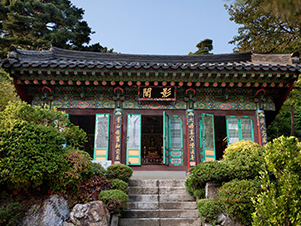 The statue of Jijang Bodhisattva Triad is enshrined on the alter in this building. The portraits of venerable seven monks who greatly affected the development of this temple are enshrined here, too. They are the Bongeunsa founder Master Yeonhoei, the reviver Master Bowoo, Master Seosan, Master Samy대ng, Master Yeonggi, Master Yeongam, and Master Seokju. Yeonggak also retains memorial tablets for 201 victimized Korean soldiers. Originally this seven pyung building was called Chungryunggak in 1967 and it was reconstructed to double-sized building Yeonggak in 1992.
The statue of Jijang Bodhisattva Triad is enshrined on the alter in this building. The portraits of venerable seven monks who greatly affected the development of this temple are enshrined here, too. They are the Bongeunsa founder Master Yeonhoei, the reviver Master Bowoo, Master Seosan, Master Samy대ng, Master Yeonggi, Master Yeongam, and Master Seokju. Yeonggak also retains memorial tablets for 201 victimized Korean soldiers. Originally this seven pyung building was called Chungryunggak in 1967 and it was reconstructed to double-sized building Yeonggak in 1992.
- 15. Unhadang
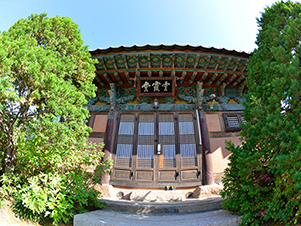 Unhadang is a Buddhist monk's practicing place and is about 20 meters west away from the Daewoongjeon (Main Buddha Hall). The foundation stone of Unhadang was the same with the stone of Daewoongjeon continuously. This place is used for Buddhist monk's place like Shimgeumdang. Unhadang was established when Bongeunsa was founded but current building was rebuilt in 1941.
Unhadang is a Buddhist monk's practicing place and is about 20 meters west away from the Daewoongjeon (Main Buddha Hall). The foundation stone of Unhadang was the same with the stone of Daewoongjeon continuously. This place is used for Buddhist monk's place like Shimgeumdang. Unhadang was established when Bongeunsa was founded but current building was rebuilt in 1941.
- 16. Shimgumdang
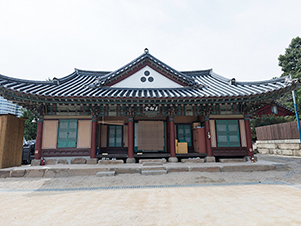 Shimgum literally means 'Searching for a Sword of wisdom ’, which cut off our ignorance not knowing what is wisdom. This hall was used for meditation. Shimgumdang is located right side of Daewoongjeon, the front size is 7 kans and the side size is 3 kans. According to the Document of Jeongleungji, this building was bulit with foundation of Bongeunsa , burned down in 1939 and was rebuilt in 1941.
Shimgum literally means 'Searching for a Sword of wisdom ’, which cut off our ignorance not knowing what is wisdom. This hall was used for meditation. Shimgumdang is located right side of Daewoongjeon, the front size is 7 kans and the side size is 3 kans. According to the Document of Jeongleungji, this building was bulit with foundation of Bongeunsa , burned down in 1939 and was rebuilt in 1941.
- 19. The Statue of Yeonji Gwanseum
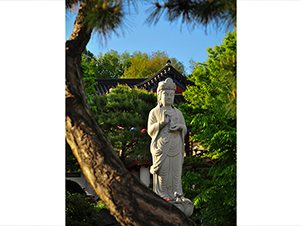 This Statue is the Avalokitesvara Bodhisattva of the lotus pond. The Statue of Yeonji Gwanseum Bosal, a symbol of the faith of Gwanseum Bosal in Korea, is placed in the center of the lotus pond. This Bodhisattva of compassion is holding a bottle of Sweet Dew in his hand, and the Amitabha Buddha is enshrined on his crown. This pond is one of the nine ponds where lotus flowers are blooming in the Western Pure Paradise of Amitabha Buddha. Avalokitesvara, the Bodhisattva of Compassion, can hear and see the sufferings of all sentient beings and save them accordingly.
This Statue is the Avalokitesvara Bodhisattva of the lotus pond. The Statue of Yeonji Gwanseum Bosal, a symbol of the faith of Gwanseum Bosal in Korea, is placed in the center of the lotus pond. This Bodhisattva of compassion is holding a bottle of Sweet Dew in his hand, and the Amitabha Buddha is enshrined on his crown. This pond is one of the nine ponds where lotus flowers are blooming in the Western Pure Paradise of Amitabha Buddha. Avalokitesvara, the Bodhisattva of Compassion, can hear and see the sufferings of all sentient beings and save them accordingly.
- 21. Hyangjeokwon( Dining Hall )
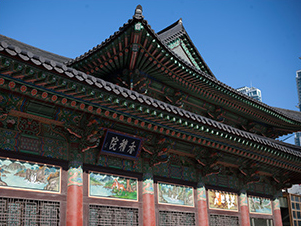 Hyangjeokwon, dining hall, has 400 seats. Opening hours; 11:30 a.m. ~12:30 p.m. (Subject to change according to the temple occasions) The cooking class of Temple cuisine is held here on every Tuesday.
Hyangjeokwon, dining hall, has 400 seats. Opening hours; 11:30 a.m. ~12:30 p.m. (Subject to change according to the temple occasions) The cooking class of Temple cuisine is held here on every Tuesday.
- 22. Bowoodang
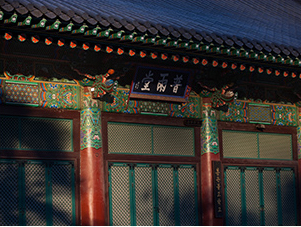 Bowoodang was built on the site of the village inside the temple compound funded by the Korean government for ASEM summit conference in October 2000. It was named after Master Bowoo who dedicated his efforts for the restoration of Korean Buddhism. Several Buddhist academic lectures- Buddhist schools, Doctrine study schools, and Elders' school-have taken place in this building. Buddhist ceremonies for children, youth, and college students are held every Sunday. Meanwhile, free clinic center for the homeless and foreign workers is running in the basement of this building.
Bowoodang was built on the site of the village inside the temple compound funded by the Korean government for ASEM summit conference in October 2000. It was named after Master Bowoo who dedicated his efforts for the restoration of Korean Buddhism. Several Buddhist academic lectures- Buddhist schools, Doctrine study schools, and Elders' school-have taken place in this building. Buddhist ceremonies for children, youth, and college students are held every Sunday. Meanwhile, free clinic center for the homeless and foreign workers is running in the basement of this building.
- 23. Daraeheon
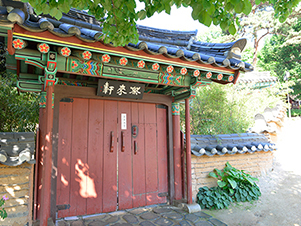 The name of this house means, "Come and have a cup of tea". In 1970 Bongeunsa became the base temple for The Dongguk Institute for Translating Sutras. So monks translated the Sutras written in Chinese characters into Korean here. Seon Master Beopjeong, a famous author of million-seller, stayed Daraeheon and wrote about his experiences here in his book `Nonpossession'.
The name of this house means, "Come and have a cup of tea". In 1970 Bongeunsa became the base temple for The Dongguk Institute for Translating Sutras. So monks translated the Sutras written in Chinese characters into Korean here. Seon Master Beopjeong, a famous author of million-seller, stayed Daraeheon and wrote about his experiences here in his book `Nonpossession'.
- 24. Bongeun Seonwon( Seon Meditation Center )
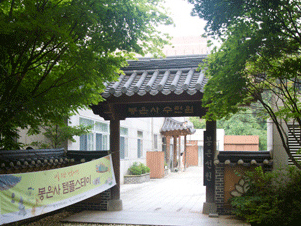 Seon(meditation) Center was built in 2002 as the urban base for traditional Buddhist culture. Buddhists practice Seon meditation here. Now various propagations of Buddhism such as Templestay program, Buddhism academy and Dharma meetings of university students are held here.
Seon(meditation) Center was built in 2002 as the urban base for traditional Buddhist culture. Buddhists practice Seon meditation here. Now various propagations of Buddhism such as Templestay program, Buddhism academy and Dharma meetings of university students are held here.
- 25. Bigak
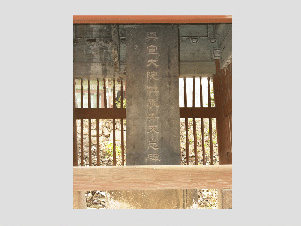 There are two memorial stones for the Regent Heungseon Daewongun and the great scholar and calligrapher Chusa Kim Jeonghee in the late Joseon Dynasty.
There are two memorial stones for the Regent Heungseon Daewongun and the great scholar and calligrapher Chusa Kim Jeonghee in the late Joseon Dynasty.
- 26. Panjeon (Tripitaka Hall)
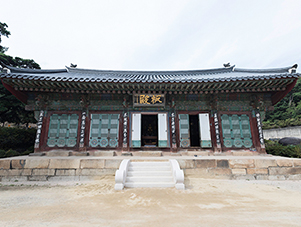
Panjeon was built in 1855 by the Venerable Yeonggi and a great scholar and calligrapher Kim Jeong-hee whose pen name was Chusa to preserve the wooden blocks of the 81 volumes of the Avatamsaka Sutra. Added later were the wooden blocks of the Vimalakirti Sutra, the Collection of Poems written by hermit Hansanja, the Initial Self-Discipline by monk Jinul and the printing of Sakyamuni Buddha's feet among others. Currently 3,438 wooden blocks are well kept in this hall. This is the oldest building in the Bongeunsa Temple where the Vairocana Buddha is enshrined. The hanging board of Panjeon and the wooden blocks of the Avatamsaka Sutra have been designated as the Tangible Cultural Property No. 83 and No. 84 of the Seoul City. The hanging board features the last work of Chusa Kim Jeong-hee as a calligrapher of the Joseon Dynasty.
- 27. Mireukjeon( Maitreya Hall )
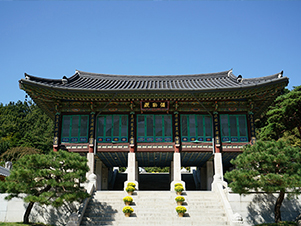 This Building was moved here from the place of Beopwangru. It is in front of the Great Statue of Maitreya Buddha.
This Building was moved here from the place of Beopwangru. It is in front of the Great Statue of Maitreya Buddha.
- 28. The Great Statue of Maitreya Buddha
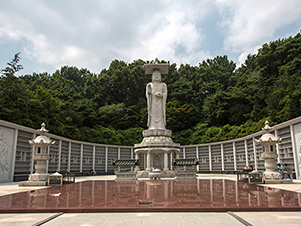 The Great Statue of Maitreya Buddha was built by Master Yeongam from 1986 to 1996. More than ten thousand Buddhist monks, nuns, laymen, and laywomen of Bongeunsa had prayed and donated for the Great Statue. The statue is 23 meters high, the tallest stone statue in Korea. The square in front of the Statue is used for prayers, cultural events, and performances.
The Great Statue of Maitreya Buddha was built by Master Yeongam from 1986 to 1996. More than ten thousand Buddhist monks, nuns, laymen, and laywomen of Bongeunsa had prayed and donated for the Great Statue. The statue is 23 meters high, the tallest stone statue in Korea. The square in front of the Statue is used for prayers, cultural events, and performances.
Nation-Designated Cultural Properties
Bronze Incense Burner inlaid with silver thread in Bongeunsa Temple National Treasure No.321
- Period : CE 1344
- Location : Central Buddhist Museum
One hundred and three letters are inscribed on Bongeunsa Bronze Incense Burner inlaid with silver thread. By this inscription, it is known to be made by Kim Kyung who was a master artisan, with Ven. Oyeo, Ven. Jinoh, and Ven. Gyeho in the fifth year of 28th King Chunghae of Koryo Dynasty in CE1344. Incense Burner is an offering tool to the Buddha used in the temple for incense burning . Incense is a symbol of Buddha's teachings and the mind purification.
This Bronze Incense Burner is believed to be originally located at Jungheungsa Temple in Mt. Bukhansan and transferred to Bongeunsa during King Myeongjong in Joseon Dynasty. The period of King Myeongjong was 150 years later of the foundation of Joseon Dynasty, which suppressed Buddhism. But Queen Munjeong, mother of King Myeongjong, was a sincere Buddhist, she nominated Ven. Bowoo as the Head monk of Bongeunsa Temple. He revived both section of Seon and Doctrine of Buddhism in 1550, and established Sunggwa, the examination to become a Buddhist monk, the next year.
The reason why Bronze Incense Burner was transferred to Bongeunsa Temple, the center of reviving Buddhism, was because of the earnest vow of Ven. Bowoo and all Buddhists whom wanted Buddha's teachings to spread from Bongeunsa. to whole country. Now, as the power of vow, Bongeunsa represents Buddhist temples of Seoul, Korea.
This Bronze Incense Burner is shown not only the good proportion of appearance but also lots of beautiful patterns on surface, and the inlay with silver thread is done refinedly. It is exhibited at Central Buddhist Museum.
Wooden Statues of Sakyamuni Triad in Bongeunsa Temple
National Treasure No. 1819
- Period : CE1651
- Location : Daewoongjeon
Wooden Statues of Sakyamuni Triad in the Main Buddha Hall of Bongeunsa Temple are designated as National Treasure No. 1819, in March 12, 2014. Monk Seungil who was the great Sculptor in the late Joseon Dynasty (the 2nd years of King Hyojong's reign :CE1651), came to Bongeunsa Temple and saw the most buildings seriously destroyed by war. So he newly made the statues of the Sakyamuni, Bhaisagyaguru and Amitabha Buddhas, called Statues of Sakyamuni Triad, with all his sincere energy and ten Buddhists' earnest vows. And the Statues of Sakyamuni Buddha Triad were enshrined on the alter in the Main Buddha Hall [Daewoongjeon]. According to the Gaegeumgi (Document of Gild Work) in 1765, Sakyamuni Buddha Statue was damaged again by fire in 1689 and repaired afterwards.
The wooden Statues of Sakyamuni Buddha Triad are the representative of Buddhist sculptures from the mid-17th century showing power in a simple image, They are Buddhas of Hope saving satient beings from all sufferings. They will remain as the great National Treasure in Korea.
The Sitting Buddha Triad, not only showing the outstanding figures from the sculptural point of view but also equipped with a statement of aspiration, is evaluated as one of the important Buddhist Cultural Properties in understanding the post mid-17th century Buddhist sculptures. The Sakyamuni Buddha Triad enshrined in the Main Buddha Hall is the Buddha of Hope who soothes the sufferings of all sentient beings and helps fulfill their wishes. This Sakyamuni Buddha Triad will remain as a National Cultural Heritage of Korea as well as a Buddhist Cultural Property of Korea for a long and long time.


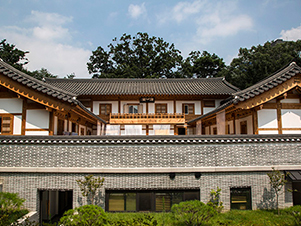
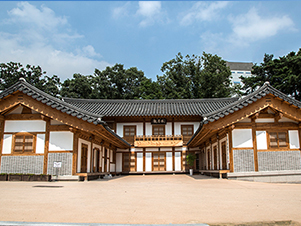
 Bell tower was built in 1974, is no longer used lately and it is well preserved now.
Bell tower was built in 1974, is no longer used lately and it is well preserved now.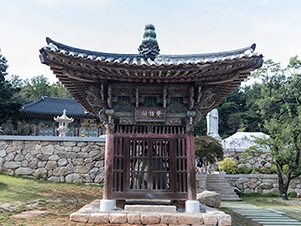
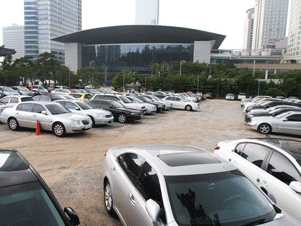 Parking facility
Parking facility